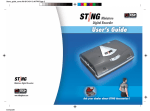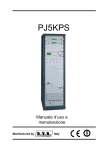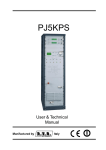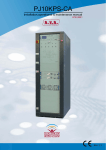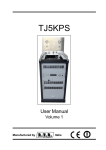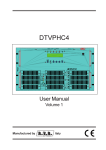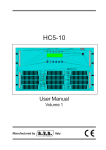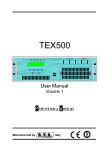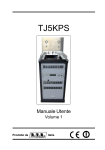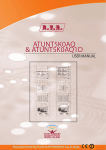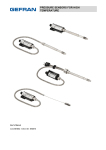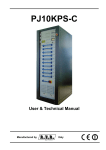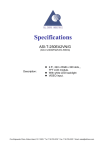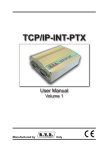Download TX10KPS
Transcript
TX10KPS User Manual Manufactured by Italy File Name: TX10KPS.P65 Version: 1.0 Date: 19/11/2002 Revision History Version Date 1.0 19/11/2002 Reason New Version Editor D. Canazza TX10KPS - User Manual Version 1.0 © Copyright 2002 R.V.R. Elettronica SpA Via del Fonditore 2/2c - 40138 - Bologna (Italia) Telefono: +39 051 6010506 Fax: +39 051 6011104 Email: [email protected] Web: www.rvr.it All rights reserved Printed and bound in Italy. No part of this manual may be reproduced, memorized or transmitted in any form or by any means, eletronic or mechanic, including photocopying, recording or by any information storage and retrieval system, whithout the permission of the copyright owner. Notification of intended purpose and limitations of product use This product is a FM transmitter intended for FM audio broadcasting. It utilises operating frequencies not harmonised in the intended countries of use. The user must obtain a license before using the product in intended country of use. Ensure respective country licensing requirements are complied with. Limitations of use can apply in respect of operating freuency, transmitter power and/or channel spacing. Declaration of Conformity Hereby, R.V.R. Elettronica SpA, declares that this FM transmitter is in compliance with the essential requirements and other relevant provisions of Directive 1999/5/EC. This page intentionally left blank TX10KPS Table of Content 1. 2. 3. 3.1 3.2 4. 4.1 4.2 4.3 5. 5.1 5.2 5.3 5.4 5.5 5.6 Preliminary Instructions Warranty First Aid Treatment of electrical shocks Treatment of electrical Burns General Description Composition Technical specifications Working principles Installation and use Installation First start Quick reference for SCM1+1LCD Quick reference for PTX-LCD Quick reference for HC2 Quick reference for PJ5KPS User Manual Rev. 1.0 - 99/11/02 1 3 5 5 6 7 7 10 11 13 13 13 15 22 23 24 i TX10KPS Pagina lasciata intenzionalmente in bianco ii Rev. 1.0 - 19/11/02 User Manual TX10KPS 1. Preliminary Instructions This manual is written as a general guide for those having previous knowledge and experience with this kind of equipment, well conscious of the risks connected with the operation of electrical equipment. It is not intended to contain a complete statement of all safety rules which should be observed by personnel in using this or other electronic equipment. The installation, use and maintenance of this piece of equipment involve risks both for the personnel performing them and for the device itself, that shall be used only by trained personnel. R.V.R. Elettronica SpA doesn’t assume responsibility for injury or damage resulting from improper procedures or practices by untrained/unqualified personnel in the handling of this unit. Please observe all local codes and fire protection standards in the operations of this unit. WARNING: always disconnect power before opening covers or removing any part of this unit. Use appropriate grounding procedures to short out capacitors and high voltage points before servicing. WARNING: this device can irradiate radio frequency waves, and if it’s not installed following the instructions contained in the manual and local regulations it could generate interferences in radio communications. This is a "CLASS A" equipment. In a residential place this equipment can cause hash. In this case can be requested to user to take the necessary measures. R.V.R. Elettronica SpA reserves the right to modify the design and/or the technical specifications of the product and this manual without notice. User Manual Rev. 1.0 - 19/11/02 1 / 28 TX10KPS This page was intentionally left blank 2 / 28 Rev. 1.0 - 19/11/02 User Manual TX10KPS 2. Warranty Any product of R.V.R. Elettronica is covered by a 24 (twenty-four) month warranty. For components like tubes for power amplifiers, the original manufacturer’s warranty applies. R.V.R. Elettronica SpA extends to the original end-user purchaser all manufacturers warranties which are transferrable and all claims are to be made directly to R.V.R. per indicated procedures. Warranty shall not include: 1 danni verificatisi durante la spedizione della macchina alla R.V.R. per eventuali riparazioni; 2 Any unauthorized repair/modification; 3 Incidental/consequential damages as a result of any defect 4 Nominal non-incidental defects 5 Re-shipment costs or insurance of the unit or replacement units/parts Any damage to the goods must be reported to the carrier in writing on the shipment receipt. Any discrepancy or damage discovered subsequent to delivery, shall be reported to R.V.R. Elettronica within 5 (five) days from delivery date. To claim your rights under this warranty, you shold follow this procedure: 1 Contact the dealer or distributor where you purchased the unit. Describe the problem and, so that a possible easy solution can be detected. Dealers and Distributors are supplied with all the information about problems that may occur and usually they can repair the unit quicker than what the manufacturer could do. Very often installing errors are discovered by dealers. 2 If your dealer cannot help you, contact R.V.R. Elettronica and explain the problem. If it is decided to return the unit to the factory, R.V.R. Elettronica will mail you a regular authorization with all the necessary instructions to send back the goods. 3 When you receive the authorization, you can return the unit. Pack it carefully for the shipment, preferably using the original packing and seal the package perfectly. The customer always assumes the risks of loss (i.e., R.V.R. is never responsible for damage or loss), until the package reaches R.V.R. premises. For this reason, we suggest you to insure the goods for the whole value. Shipment must be effected C.I.F. (PREPAID) to the address specified by R.V.R.’s service manager on the authorization DO NOT RETURN UNITS WITHOUT OUR AUTHORIZATION AS THEY WILL BE REFUSED User Manual Rev. 1.0 - 19/11/02 3 / 28 TX10KPS 4 Be sure to enclose a written technical report where mention all the problems found and a copy of your original invoice establishing the starting date of the warranty. Replacement and warranty parts may be ordered from the following address. Be sure to include the equipment model and serial number as well as part description and part number. R.V.R. Elettronica SpA Via del Fonditore, 2/2c 40138 BOLOGNA ITALY Tel. +39 051 6010506 4 / 28 Rev. 1.0 - 19/11/02 User Manual TX10KPS 3. First Aid The personnel employed in the installation, use and maintenance of the device, shall be familiar with theory and practice of first aid.. 3.1 3.1.1 Treatment of electrical shocks If the victim is not responsive Follow the A-B-C's of basic life support • Place victim flat on his backon a hard surface. • Open airway: lift up neck, push forehead back (Fig. 3-1). • clear out mouth if necessary and observe for breathing • if not breathing, begin artificial breathing (Figure 3-2): tilt head, pinch nostrils, make airtight seal, four quick full breaths. Remember mouth to mouth resuscitation must be commenced as soon as possible Figure 3-1 • Figure 3-2 Check carotid pulse (Fig 3-3); if pulse is absent, begin artificial circulation (Fig. 3-4) depressing sternum (Fig. 3-5) Figure 3-3 Figure 3-4 Figure 3-5 • In case of only one rescuer, 15 compressions alternated to two breaths. • If there are two rescuers, the rythm shall be of one brath each 5 compressions. • Do not interrupt the rythm of compressions when the second person is giving breath. • Call for medical assistance as soon as possible. User Manual Rev. 1.0 - 19/11/02 5 / 28 TX10KPS 3.1.2 3.2 3.2.1 If victim is responsive • Keep them warm • Keep them as quiet as possible • Loosen their clothing (a reclining position is recommended) • Call for medical help as soon as possible Treatment of electrical Burns Extensive burned and broken skin • Cover area with clean sheet or cloth • Do not break blisters, remove tissue, remove adhered particles of apply any salve or ointment. • Treat victim for shock as required. • Arrange transportation to a hospital as quickly as possible. • If arms or legs are affected keep them elevated clothing, or If medical help will not be available within an hour and the victim is conscious and not vomiting, give him a weak solution of salt and soda: 1 level teaspoonful of salt and 1/ 2 level teaspoonful of baking soda to each quart of water (neither hot or cold). Allow victim to sip slowly about 4 ounces (half a glass) over a period of 15 minutes. Discontinue fluid if vomiting occurs DO NOT give alcohol 3.2.2 6 / 28 Less severe burns • Apply cool (not ice cold) compresses using the cleansed available cloth article. • Do not break blisters, remove tissue, remove adhered particles of clothing, or apply salve or ointment. • Apply clean dry dressing if necessary. • Treat victim for shock as required. • Arrange transportation to a hospital as quickly as possible • If arms or legs are affected keep them elevated. Rev. 1.0 - 19/11/02 User Manual TX10KPS 4. General Description The TX10KPS is a RF transmitter for frequency modulation sound broadcasting. It is a fully solid-state apparatus of modern design that uses MOSFET as active components in the FM amplifying modules. This chapter briefly describes the machine's main features. 4.1 Composition TX10KPS transmitter is made up of: • 2 PJ5KPS amplifiers, each composed by: • 5 1.2 kW RF amplifier modules • 1 Control unit • 1 or 2 Power supply unit carriages • 1 Splitter/Input RF • 1 Combiner for amplifiers RF outputs; • 1 HC2 splitter to split the driver power; • 2 PTX100LCD exciters in automatic changeover configuration; • 1 SCM1+1LCD automatic changeover unit; • 1 2,5kW dummy load for the absorption of the unbalanced power of the two 5kW amplifiers. The standard configuration of the TX10KPS foresees two 19”-40HE racks (see figure 4-1). The manufacturer will produce upon customers request special configurations, see the example in figure 4-2. The transmitter is supplied complete with all its parts, not really "modules", essential for its operation such as the blowers for dissipating the heat generated by the machine inside the room and all the accessories for the electrical and RF wiring. NB This manual gives system-level information about the TX10KPS. Further details about the operation of the single components please refer to the relative manuals, that are attached to the present one and should be considered a part of it: • PJ5KPS, • PTX-LCD • SCM1+1LCD • HC2 User Manual Rev. 1.0 - 19/11/02 7 / 28 TX10KPS Figure 4-1 PJ10KPS configuration made in 2 racks 8 / 28 Rev. 1.0 - 19/11/02 User Manual TX10KPS Figure 4-2 PJ10KPS made in 3 racks User Manual Rev. 1.0 - 19/11/02 9 / 28 TX10KPS 4.2 Technical specifications The following table gives an overview of the main specifications of the transmitter. More data (for example input type or A/F response) are given in the exciter’s manual. Frequency range Nominal RF power Max. continuous RF power Power supply voltage Exciting power Consumption Power factor Weight 87.5 - 108.0 MHz 10000 W 11000 W 400V Three-phase, 3F+N Approx. 60 W < 16.5 kW > 0.95 230 kg (each PJ5kPS rack) 19 kg (each 1.2 kW RF amp. module) 140 kg (each transformer/rectifier module) 16 kg (each exciter) 8 kg (changeover unit) More important features of the TX10KPS are the following: 10 / 28 • The 1.2 kW amplifying modules are implemented using state-of-the-art plug-in technology: the individual modules may be removed, for instance to perform maintenance operations, without having to turn off the transmitter. The transmitter keeps working at reduced power even if the module has been removed. This operation may be carried out without any risk of damaging the module itself, or the amplifier as a whole, thanks to the control system, RF and power supply purposely designed connectors. Further information are given in the maintenance section of the PJ5KPS amplifier. • Each module is controlled by a microprocessor-based card that checks and adjusts its operating mode. The resulting data are transmitted to the control unit. • The SCM1 changeover unit manages the changeover of the two exciters both in automatic and manual mode. • Each amplifier may be equipped with a dual power supply/rectifier module. This configuration is a “hot stand-by” redundant one, since both supply under normal conditions half of the current required by the machine to work. If one module is absent or faulty, the module that is present supplies all the required current by itself. The sufficient dimensioning of each power supply unit guarantees that the machine will work efficiently at its nominal power level. The power supply/rectifier modules are hot-swappable. • The amplifier can work as usual even if the control unit is not present, for example for maintenance. In fact, the control unit may be substituted temporarily with an electromechanical interface by means of which the user may give the ON and OFF commands to the machine. However, in this case all the numeric type information will be missing and the power level remains the last one enabled before removing the control unit. Rev. 1.0 - 19/11/02 User Manual TX10KPS 4.3 Working principles The following description is based on the block diagram given in Figure 4-3. The configuration of the PJ10KPS is designed to minimize the risks of service interruptions, thanks to redundancy of the components and of the design. ANTENNA DUMMY LOAD POWER METERS FWD & RFL PWR Sampling - + 3dB PJ5000M-C B PJ5000M-C A Inhibit commands Splitter Switch command Relè coax. PTX100LCD #1 SCMLCD1+1 Changeover Unit PTX100LCD #2 Figure 4-3 Schematic TX10KPS operation The RF power output of the exciters are connected to the coaxial relay that is controlled by the automatic changeover unit SCM1+1LCD, that can be configured for manual or automatic operation. In manual mode, the unit doesn’t perform any check on the power or modulation level of the exciters. An exchange changeover will only be remotely performed using the telecontrol software, or locally pushing the encoder when the cursor on the LCD display highlights the coaxial relay on the main screen. In automatic mode, the changeover unit continuosly cheks the power output level of the PTX-LCD exciters and, if so configured, theyr audio levels. The stand-by exciter User Manual Rev. 1.0 - 19/11/02 11 / 28 TX10KPS will be automatically activated in place of the main exciter when the exciter level falls below a programmed threshold (or if the audio fails). The coaxial relay is operated accordingly to route the correct exciter’s output into the input of the splitter. Also in case of changeover unit in automatic mode, the exciters changeover can be commended manually using the telecontrol software or the SCM1 interface. The HC2 splitter divides the RF signal of the selected exciter into two branches, each of which is passed to the input of one of the PJ5KPS. The RF signals are amplified and and then filtered by the low pass filters built in the amplifier. The two RF amplified signals at the amplifiers output are combined by a 3dB coupler and passed to the antenna. Possible unbalancement power (for example in case one of the amplifiers is working at reduced power during maintenance operations) is dissipated by the included dummy load. 12 / 28 Rev. 1.0 - 19/11/02 User Manual TX10KPS 5. Installation and use This chapter contains the basic instructions for installing and using the TX10KPS . If necessary, more depth information about the operating principles may be found in the components’ manuals. 5.1 Installation For practical reasons and for transport safety, the machine is usually supplied disassembled to the customer. The assembly procedure is rather simple and can be carried out by any qualified technician. Caution: In order to avoid the risk of damaging the machine and/or of injuring the operators, it is advisable to closely adhere to the instructions provided below. always respect all the safety regulations and standards in force. Unpack the amplifier and before any other operation check that the amplifier hasn’t been damaged during transport and all the controls and connectors on the front and rear panels are in good condition. To install the PJ5KPS amplifiers racks please refer to the relative manual, particularily about: • RF amplifier modules insertion; • Power supply carriages insertion; • Mains supply connection Perform the RF connections between the amplifiers following the instructions and schematics given in the station’s documentation (technical dossier). 5.2 First start This section describes the procedure for powering-on the machine the first time. For a description of the power up procedure of the single amplifiers in the different cases, of the use of the exciters, the changeover unit and of the splitter, please consult the relative manuals. 5.2.1 Preliminary operations Before activating the apparatus, please perform the necessary connections, that is: • Power supply • Modulating signals • RF load It is advisable to run the first tests connecting the transmitter to a suitable (for type and power) dummy load rather than to the transmission antenna. User Manual Rev. 1.0 - 19/11/02 13 / 28 TX10KPS 5.2.2 Power-on When powering-on the transmitter the first time, perform the operations below to work efficiently in less time as possible. • Switch on the mains supply, keeping the exciters at theyr minumum power level. At power up, the PTXLCD exciters display reports the frequency and power level; if these are not as required, just push the encoder button to temporarily deactivate the power output. • Set the SCM1+1LCD changeover unit in manual mode. • Set the nominal output power level of the amplifiers using the buttons of the control units as described in the following of this manuals. The amplifiers are linked together, so that the power level can be set in just one of the amplifiers. • Switch the amplifiers in ON mode with the buttons in the control units. • Enable the exciter currently connected to the amplifier through the coaxial relay. Rise its output power until the output power of the amplifier reaches its required value. • Using the changeover unit, exchange the exciters’ role, and repeat the preceeding operation. • Put the exciters in automatic changeover mode on the SCM1+1LCD. • If the working frequency of the amplifier was changed, the overall efficiency of the transmitter can be maximized adjusting the phase of the HC2 outputs for the exciters. The transmitter is now up and running at its nominal power level. It is then possible to perform all the controls and verification that one thinks are necessary before putting it into operation. 14 / 28 Rev. 1.0 - 19/11/02 User Manual TX10KPS 5.3 Quick reference for SCM1+1LCD The purpose of this section is to summarize the points that should be adhered to for using the machines. Should any point not be fully comprehensible, such as how to operate the machine the first time, the description of the operating system should be read very carefully on realtive manual. 5.3.1 Using the encoder The following operations are performed on the encoder: Turn the encoder counterclockwise to move the cursor downwards, to decrease the value of a parameter or to choose an element from a list of possibilities Turn the encoder clockwise to move the cursor upwards, to increase the value of a parameter or to choose an element from a list of possibilities Push the button once to enter in the desired menu, to enter in modification mode or to confirm a choice • turning: to move the cursor up or down on the display; turn the encoder to the left to move the cursor down, to the right to move the cursor up. Also used for increasing or decreasing the selected parameters (to the left to decrease the value, to the right to increase it) and for selecting an item from a list of options • pressing: press the button once when the cursor is pointing to the name of a menu to access that menu, press the button when the cursor is pointing to a parameter to access the change mode (the cursor begins to blink). After having changed a parameter, press the button to store the new value. After having changed a parameter, the cursor keeps blinking for about thirty seconds waiting for confirmation. If the user does not confirm the change, the machine emits a sound to warn the user that the change was not confirmed. As such, the cursor stops blinking and points to the selected parameter. User Manual Rev. 1.0 - 19/11/02 15 / 28 TX10KPS 5.3.2 Manual change over To set the manual change over mode, select the "RETRY" number in the main screen page and set it to zero. If the icon does not appear, select and press the encoder. This type of operation inhibits controls of the power and, if necessary, of the PTXLCD input: change over between the two PTX-LCD can only be provoked remotely with the remote control software, or locally by pressing the encoder when the arrowshaped cursor indicates the coaxial relay in the main screen page. The individual transmitters may be switched on and off, when not using the change over function, by pressing the encoder when the arrow-shaped cursor indicates the required transmitter. NECESSARY CONDITIONS FOR THE MANUAL OPERATION MANUAL LED = ON RELAY LEDS = OFF POWER GOOD ANTENNA = ON CROSSED AUTOMATIC ICON AND RETRY NUMBER = 0 TXA ON ANTENNA TXB ON LOAD 5.3.3 Automatic change-over To set the automatic change over mode, select the required "RETRY" number in the main screen page, select the icon at the top right-hand corner of the menu and press the encoder. This type of operation enables controls of the power and, if necessary, of the PTXLCD input: the stand-by transmitter is activated automatically in lieu of the main transmitter when power is insufficient at PTX-LCD output. Even in this case change over between the two PTX-LCD can be provoked remotely with the remote control software, or locally by pressing the encoder when the arrow-shaped cursor indicates the coaxial relay in the main screen page. 16 / 28 Rev. 1.0 - 19/11/02 User Manual TX10KPS The individual transmitters may be switched on and off, when not using the change over function, by pressing the encoder when the arrow-shaped cursor indicates the required transmitter. NECESSARY CONDITIONS FOR THE AUTOMATIC OPERATION MANUAL LED = OFF RELAY LEDS = ON POWER GOOD ANTENNA = ON NOT CROSSED AUTOMATIC ICON AND RETRY NUMBER > 0 TXA ON ANTENNA TXB ON LOAD The wait time for every single change over is managed by and set in the "WAIT" menu. 5.3.4 Alarm conditions The different possible conditions indicated by the SCM are described in another section. User Manual Rev. 1.0 - 19/11/02 17 / 28 TX10KPS 5.3.4.1 Transmitter This occurs when the level of power supplied by TX drops below the analog Power Good level set and the digital Power Good input simultaneously goes to a high logic level, i.e.: when both of the Power Good inputs generate an alarm. This is the reason why only one of the two must be used: analog, inserting the pull-up at the digital input, or digital, leaving the analog input open. Procedure for the management of a TX fault: • switch off TX; • check that TX is switched off; • switch the coaxial relay; • check that the coaxial relay has switched; • switch on TXB. The exclamation mark, which indicates TX fault, is displayed until the alarms are reset. Both transmitters weigh the same and the change over is managed in both directions as many times as indicated in the "RETRY" number. 5.3.4.2 Audio signal missing (PTX-LCD only) The audio signal presence control is carried out only if the exciter of the transmitters is a PTX-LCD series exciter; controls of this type, and relative management, are carried out only on the active exciters. Management procedure for a missing audio signal on the transmitter: • switch off TX; • check that TX is switched off; • switch the relative coaxial relay; • check that the coaxial relay has switched; • switch on TXB. The exclamation mark, which indicates automatic transmitter change over, is displayed until the alarms are reset. 18 / 28 Rev. 1.0 - 19/11/02 User Manual TX10KPS 5.3.4.3 Dummy load fault This situation is linked to overheating of the dummy load or absence of load ventilation, detected by special sensors. The SCM indicates this fault locally and remotely. 5.3.4.4 Coaxial relay fault If the position signals from the coaxial relay are not coherent with the commands issued to it, the SCM considers the coaxial relay faulty, sets itself to manual mode and indicates this condition locally and remotely. 5.3.4.5 No mains power If the SCM has battery backup, it can cope with an interruption of the mains power supply. System status is frozen during the mains power cut. When mains power is restored, the SCM waits until the power-up wait time set in the "WAIT" menu has elapsed and then takes into consideration any alarm conditions. Therefore, set the power-up wait time to approx. 3 minutes, so that the various devices of which the system is composed have time to return to their normal operating states when mains power is restored, and the SCM does not provoke an unwanted change over. 5..3.4.6 Alarm default codes CODE 001 002 003 004 005 006 007 008 009 010 ≥ 011 Indication Trasmitter Fault Load Fault Sw.Coax Fault RESERVED No Audio Low Power Fault Mains Power Fault Mod I2C Restart Interlock Meant Transmitter damage Dummy load damage Coaxial relay damage RESERVED Absence of audio signal Low power (–3dB) amplifier (*) Absence of mains power I2C module damage System restart Automatic change over Inhibition General alarms adjustable from user (*): Only for systems with dual exciter. User Manual Rev. 1.0 - 19/11/02 19 / 28 TX10KPS 5.3.5 Alarm indications The SCM indicates faults locally and remotely, by sending a series of messages according to methods which depend on the SCM configuration. As is the case for alarm management, the SCM waits until the alarm management time set has elapsed before issuing indications. 5.3.5.1 5.3.5.2 5.3.5.3 5.3.5.4 20 / 28 Local indication • The GENERAL ALARM LED on the front panel lights up; • a line is added to the "Alarm" menu, indicating the time, date and code of the alarm. Remote indication by data-phone modem • The SCM calls all of the set telephone numbers in sequence and communicates the code, the TX in question and the alarm description (at the other end of the line a PC with the "Hyper Terminal" software, supplied with all Windows™ environments, must be connected in stand-by); • the SCM repeats the series of calls, the number of times indicated in the remote programming, via remote control software. Remote indication by pager • The SCM calls all of the set pager numbers in sequence, communicating the relative alphanumeric code; • it calls all of the set telephone numbers in sequence and communicates the code, the TX in question and the alarm description (at the other end of the line a PC with the "Hyper Terminal" software, supplied with all Microsoft Windows operating systems, must be connected in stand-by); • the SCM repeats the series of calls, the number of times indicated in the remote programming, via remote control software. Remote indication by GSM modem • The SCM calls all of the set pager or modem numbers in sequence, communicating the relative alphanumeric code; • it calls all of the telephone numbers indicated in the remote control software programming and communicates the code, the TX in question and the alarm description by means of SMS text messages. Rev. 1.0 - 19/11/02 User Manual TX10KPS NECESSARY CONDITIONS TO SEND SMS MESSAGES MODEM = GSM BAUD RATE = 9600 MODEM = PRESS FOR LEVEL Keep in mind that to send SMS messages, the device must be programmed by the specific TELECON program in order to enter the number of the Service Center, which is essential for sending messages correctly. User Manual Rev. 1.0 - 19/11/02 21 / 28 TX10KPS 5.4 Quick reference for PTX-LCD The purpose of this section is to summarize the points that should be adhered to for using the machines. Should any point not be fully comprehensible, such as how to operate the machine the first time, the description of the operating system should be read very carefully on realtive manual. 5.4.1 Using the encoder The use of the encoder is the same to that one previously described. See chapter 5.2.3.1 for doubts or clarifications. 5.4.2 Operating Switch on the exciter with the mains switch on the front panel. All the STATUS and ALARMS leds are lit on to permit the verification of their good working status. The display than shows some information regarding the exciter. After some seconds, the user is invited by the sound of a buzzer and by a message on the display, to push the encoder if the current settings are not acceptable. If the use pushes the encoder while the message is displayed, the exciter will start in stand-by mode, that is completely working but with RF power disabled. If the encoder is not pushed, the start-up sequence goes on undisturbed. At start-up, the various modifiable parameters will be set as they were before the machine was switched off (i.e., 98.00 % MHz and 0 % are just example values): the current parameters are in fact always stored in non-volatile memory. When the settings are not correct, for example at the first start up of the machine or if for some reason it is necessary to change some parameters before starting to transmit, it is possible to keep the exciter in stand-by mode, as seen above. 22 / 28 Rev. 1.0 - 19/11/02 User Manual TX10KPS This operation is necessary only if one wants to modify the device’s settings before starting transmitting. Using the menu system provided by the PTX-LCD, described in used manual, it is possible to control all the working parameters of the device. Specifically, before enabling the power output, we suggest to verify and in case to correct according to your needs the fundamental parameters: • frequency • power • audio input level • audio input impedance • preemphasys • kind of audio input (depending on the version, MONO or MPX or MONO, MPX_U, MPX_B, STEREO) • if in STEREO mode, verify that pilot tone is enabled If you disabled the power output, it is now possible to activate entering in the main menu, selecting the first item and changing it from OFF to ON. It is any time possible to disable the power output of the PTX-LCD, from the main menu. 5.5 Quick reference for HC2 The purpose of this section is to summarize the points that should be adhered to for using the machines. Should any point not be fully comprehensible, such as how to operate the machine the first time, the description of the operating system should be read very carefully on realtive manual. 5.5.1 Operation To perform its intended pourpose, the HC2 is always used in a transmitter comprising an exciter and two RF amplifiers. In the following description, we will in general refer to these external devices. As soon as the HC2 is supplied, verify that the ON LED is lit. The LCD display shows a presentatio screen, and after a few seconds it will pass to the default screen, showing the values of the forward and reflected power. Switch the exciter on (at its minimum power level) and wait for it to lock on the working frequency. When the PLL has locked, progressively increase its output power, while controlling the displays of the exciter, of the amplifiers and of the hybrid coupler. Keep increasing the exciter output overall output of the combiner reaches the desired value, that is at most the nominal power rating of the transmitting station. At this point, it is possible for the user to verify all the working parameters of the amplifier using the management software. User Manual Rev. 1.0 - 19/11/02 23 / 28 TX10KPS Normally, the device doesn’t require any human supervision for its normal operation. If any alarm condition arise, these are automatically managed by the embedded protection system, and notified to the user with the LEDs on the panel or via messages on the LCD display. 5.6 Quick reference for PJ5KPS The purpose of this section is to summarize the points that should be adhered to for using the machines. Should any point not be fully comprehensible, such as how to operate the machine the first time, the description of the operating system should be read very carefully on realtive manual. 5.6.1 Amplifier check The operator controls and checks the status of the PJ5KPS by means of the control unit. Three control groups are present on this unit: 5.6.1.1 o LCD and scroll buttons o Buttons, selector switches and LEDs o Analog instrument and rotary selector switch Display LCD The operator uses the control software of the transmitter by means of a series of 24 / 28 Rev. 1.0 - 19/11/02 User Manual TX10KPS menus that are displayed on the LCD. Four specific keys are provided for scrolling through the menus, performing the settings and giving the commands: Pulsante OK ESC Descrizione Click this button to access a sub-menu, to enter the editing mode or to confirm a modified value. Click this button to exit from a menu or to cancel the modification of a value. Click this button to scroll inside a menu (to the right or down) or to reduce the value of a parameter being modified. Click this button to scroll inside a menu (to the left or up) or to increase the value of a parameter being modified. When the operator is not using the various buttons to navigate, the LCD displays the preset screenful that shows the overall status of the machine's modules (Figure 5-1). The control unit acquires, every second, the status of the other modules by means of an RS485 serial bus. The activity at the bus is signaled by the "BUS INT" LEDs on the unit's panel. As indicated on the preset screenful, push the ESC button to access the screenful for selecting the menus (Figure 5-2). On reaching the selection screenful, move the cursor (full rectangle) using the arrow keys to display the concerned line. Then click OK to access the associated menu. Select the "General Status" menu to return to the preset screenful. 5.6.1.2 Buttons, selector switches and LEDs The typical machine-control operations are performed using the buttons of the control Figure 5-1 Default screenful User Manual Rev. 1.0 - 19/11/02 25 / 28 TX10KPS Figure 5-2 Menu select screenful unit's panel. Specific LEDs correspond to each button and selector switch for indicating the machine's status. The functions performed by the controls are as follows: Function OFF Description Button for turning off the machine. A LED signals that the machine is OFF. In this status, the exciters and the fan are off and the RF amplifying modules are not powered. STDBY Button for setting the machine in standby. In this status the transmitter does not emit any power, but is ready to start the transmission: the main blower is on, the RF modules are not powered, the exciters are on but locked by means of an interlock. The stand-by is used to test the exciters, in fact in manual modality the operator could arrange them in base to the own requirements; coming from an “On” in manual modality, the system does not touch the interlock. Stand-by status is signalled from a LED. In manual and in stand-by the inhibit of the device doesn't intervene on the interlock of the exciters. This could necessary when the apparatus is in configuration n+1 for verify if the exciters are operational. ON Button for turning on the transmitter. The RF power supply is activated. LOC/REM Selector switch for setting the transmitter in remote or local mode. In local mode the buttons and the controls via the menus are active. In remote mode the buttons and the controls via the menus are inhibited and the commands may be given only remotely via the parallel interface or via the remote control software. ALARM RESET Button for zeroing the FAULT or WARNING alarms. NOMINAL POWER Click this button to set the transmitter for supplying the nominal power level. A specific LED signals this setting. The value that corresponds to the nominal level is set by the operator using the menu settings in Section 7.1.8. POWER LOWER Click this button to set the transmitter for supplying the reduced power level. A specific LED signals this set-ting. The value that corresponds to the reduced level is set by the operator using the menus. EXCITER CHANGEOVER Use this button to set the changeover system in manual or automatic mode. The signaling LED turns on when the manual mode is selected. On performing a changeover, the exciter connected to the amplifier is deviated toward the internal dummy load and vice-versa. The operator must use the exciters menu to perform the changeover in manual mode. LEDs (Wait, Warning, Fault) Other signaling LEDs are connected to the alarm states and to 26 / 28 Rev. 1.0 - 19/11/02 User Manual TX10KPS the serial data transmissions that take place among the microprocessorbased cards. The function of these LEDs is described further on in this manual. 5.6.1.3 Analog instruments Sull'unità di controllo del PJ5KPS è installato uno strumento analogico con relativo selettore rotativo che è utile per una visualizzazione immediata dei seguenti parametri: FWD PWR RFL PWR UNBAL PWR EXC1 PWR EXC2 EXT FWD PWR EXT RFL FWD EXT UNBAL 5.6.2 Transmitter direct power Transmitter reflected power Transmitter unbalancing power Power supplied by the exciter currently connected to the amplifier. This value is measured by the machine in the splitter section Power supplied by the exciter currently connected to the internal load. This value is measured by the amplifier in the splitter section Direct power of an external combiner. Reflected power of an external combiner. Unbalancing power of an external combiner. These three values are used when the transmitter is connected to a 1+1 system. The SET outputs may also be connected to these quantities. Control unit settings The settings of the control unit that are required for starting up the machine, mentioned in the powering-on procedure, are the following: 1. Setting of the power levels 2. Setting of the on air exciter Figura 5-3 Menù settings User Manual Rev. 1.0 - 19/11/02 27 / 28 TX10KPS Before performing the first operation, click the ESC button. The display shows the screenful for selecting the menus [Figure 5-2]. Click the arrow keys until the cursor highlights the line associated with the Setting menu. Click OK: the software will show the associated screenful on the display [Figure 5-3]. On having accessed the Settings menu, use the arrow keys to select the nominal power line (Pwr. Out) and click OK. Use the arrow keys to decrease or increase the indicated percentage value up to the required level. Click OK again to set this value. Repeat the operation for the line associated with the reduced power level (Pwr. Lower). NB The new power level is transmitted to the combiner module and then stored in EEPROM only when the ESC button is clicked. When inside this menu, it is advisable to check the date and time lines and update them if necessary. Note: the date and time are used only for marking the events in the alarms register. NB The date and time do not need to be updated in the transmitter in order for it to work efficiently. On having completed these settings, click ESC to return to the selection screenful. In order to set the on air exciter, select the Exciters menu [Figure 5-4]. Take into consideration the On Air Exciter line: the number to the right indicates the exciter being used. To change it simply highlight the line and click OK. Figure 5-4 Exciters Menu The exchange of the exciters is assisted from the software, that is when the commutation is carried out , the interlock comes systematized in the correct way independently from like they were. The interlock could be modified also manually in case of necessity. 28 / 28 Rev. 1.0 - 19/11/02 User Manual



































